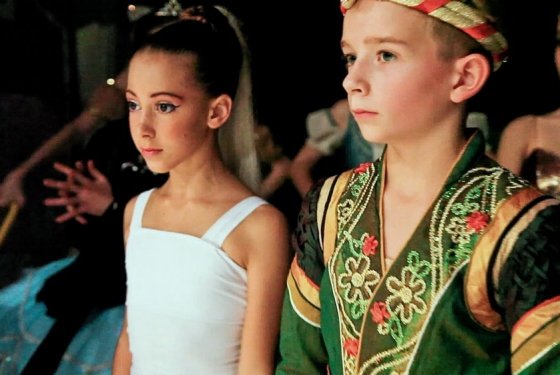 Facebook
Facebook
 X
X
 Instagram
Instagram
 TikTok
TikTok
 Youtube
Youtube

Filmmakers follow the lives of several aspiring ballet dancers from around the globe (ages 9 to 19) as they train for the Youth America Grand Prix, a prestigious dance competition in New York City that holds the potential for career stardom. The dancers offer some humanity to the generic storytelling. There is a curious paradox of maturity in them — the immature development of their bodies vs. the mature grace of their abilities; their youthful age vs. their sophisticated speech. Unfortunately, the film quality is a far cry from the poise and creativity of the performances.
Filmmakers follow the lives of several aspiring ballet dancers from around the globe (ages 9 to 19) as they train for the Youth America Grand Prix, a prestigious dance competition in New York City that holds the potential for career stardom. The documentary design that was original and invigorating in Hoop Dreams has become a formulaic superficiality. There is nothing new revealed in the storytelling arc here, as the players converge on the same climactic competition.
The dancers themselves offer some humanity to the standard proceedings. Michaela, the adopted refugee from Sierra Leone, has a grim backstory: murdered parents, a war-torn country, and racism in the dance world. By contrast, the wealthy, white, blonde cheerleader (nicknamed “Princess” at home, “Barbie” at school) comes across as vain and undisciplined, especially after watching the financial sacrifices of most of the other families. We never learn if one character is any more driven or passionate than another, but the film enjoys setting up these dynamics.
There is, however, a curious paradox of maturity in the young performers: the immature development of their bodies vs. the mature grace of their abilities; their youthful age vs. their sophisticated speech. They show a thick skin and determined will against the demands of their respective coaches: “Remember, you’re not jumping. You’re flying.”
The most compelling sequence is Joan Zamora’s (one of the older dancers) visit home to Colombia after a year’s absence. We are witness to his heartfelt family reunion and are captivated as he practices his routine in a back alley, the beauty of his movements juxtaposed against the squalor of the environment.
Unfortunately, the film quality is a far cry from the poise and creativity of the performances: grainy film stock, generic angles — more like a parent’s home movie than an aesthetic eye.


Filmmakers follow the lives of several aspiring ballet dancers from around the globe (ages 9 to 19) as they train for the Youth America Grand Prix, a prestigious dance competition in New York City that holds the potential for career stardom. The dancers offer some humanity to the generic storytelling. There is a curious paradox of maturity in them — the immature development of their bodies vs. the mature grace of their abilities; their youthful age vs. their sophisticated speech. Unfortunately, the film quality is a far cry from the poise and creativity of the performances.
Filmmakers follow the lives of several aspiring ballet dancers from around the globe (ages 9 to 19) as they train for the Youth America Grand Prix, a prestigious dance competition in New York City that holds the potential for career stardom. The documentary design that was original and invigorating in Hoop Dreams has become a formulaic superficiality. There is nothing new revealed in the storytelling arc here, as the players converge on the same climactic competition.
The dancers themselves offer some humanity to the standard proceedings. Michaela, the adopted refugee from Sierra Leone, has a grim backstory: murdered parents, a war-torn country, and racism in the dance world. By contrast, the wealthy, white, blonde cheerleader (nicknamed “Princess” at home, “Barbie” at school) comes across as vain and undisciplined, especially after watching the financial sacrifices of most of the other families. We never learn if one character is any more driven or passionate than another, but the film enjoys setting up these dynamics.
There is, however, a curious paradox of maturity in the young performers: the immature development of their bodies vs. the mature grace of their abilities; their youthful age vs. their sophisticated speech. They show a thick skin and determined will against the demands of their respective coaches: “Remember, you’re not jumping. You’re flying.”
The most compelling sequence is Joan Zamora’s (one of the older dancers) visit home to Colombia after a year’s absence. We are witness to his heartfelt family reunion and are captivated as he practices his routine in a back alley, the beauty of his movements juxtaposed against the squalor of the environment.
Unfortunately, the film quality is a far cry from the poise and creativity of the performances: grainy film stock, generic angles — more like a parent’s home movie than an aesthetic eye.
Comments